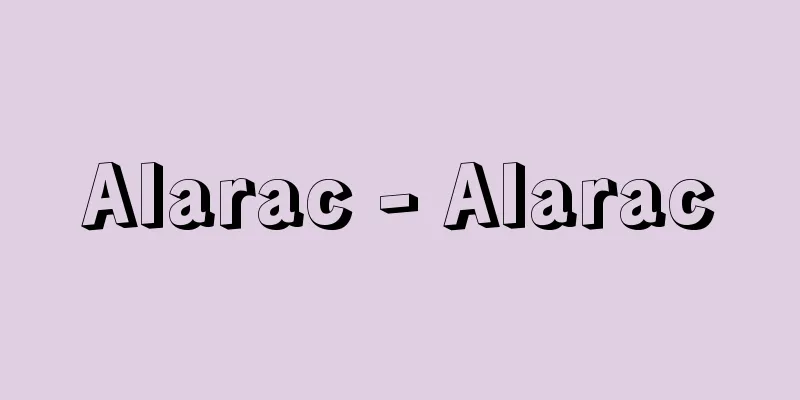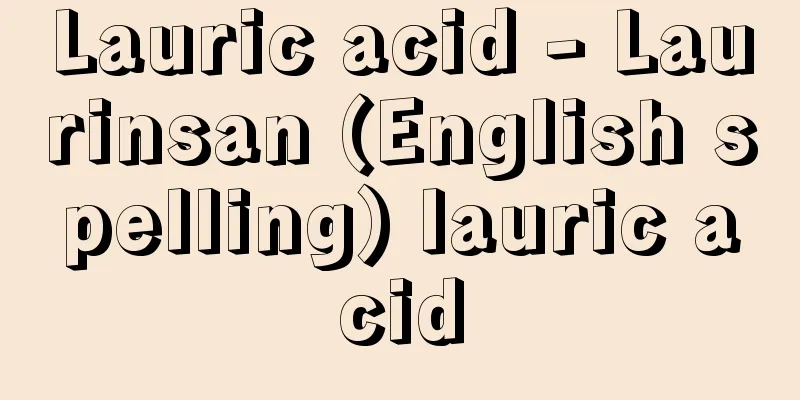Graptolite (English spelling)

|
A marine fossil animal belonging to the Hemichordates that lived in the Paleozoic era. Individuals are contained in small cup-shaped or tubular vesicles made of chitin or scleroproteins, which are attached to numerous branches that gather together to form colonies. The shapes of the colonies vary from conical, clump-like, spiral, string-like, and dendritic, ranging from millimeters to nearly a meter in size. The colonies begin as cones called sphenes, from which stalks develop with vesicles and form branches. Those with sessile life (e.g., arborescens) are entirely dendritic, and some have lateral branches without vesicles connecting the branches. Those with planktonic life (e.g., graptolites) have a small number of branches with vesicles regularly arranged in one or two rows, and the branches are thought to have been suspended from swim-bladder-like air sacs. Fossils of this species are often found in which the branches have separated into long, thin, single-edged or double-edged sawtooth shapes. Graptolites lived from the middle Cambrian to the Carboniferous period, but were more common in the Ordovician, Silurian (both periods are sometimes called the Graptolite Age) and Early Devonian periods. Graptolites in particular are used to divide and contrast strata, like Mesozoic ammonites. Although its occurrence in Japan has only been reported in recent years, it is extremely rare, but outside Japan it is distributed worldwide, especially in black shale. However, it is also found in calcareous and siliceous rocks, and some of these are well preserved, which have been used to study the structure of graptolites in detail. Because graptolites are fossil animals with a unique body structure, there have been various theories regarding their phylogenetic affiliation, including bryozoans and hydrozoans. However, based on the structure of the stolon and cell walls, it is now recognized that they have similarities to the pterygobranchs of the hemichordata (such as the modern-day Pterygota foxtail), and they are considered to be a member of the hemichordata along with the pterygobranchs. [Fujiyama Ienori] [Reference] |©Kanzo Otawa "> Graptolite morphology Source: Shogakukan Encyclopedia Nipponica About Encyclopedia Nipponica Information | Legend |
|
古生代に生存した半索動物に属する海生の化石動物。個体はキチン質あるいは硬タンパク質よりなる小さなコップ状または管状の胞の中にあり、これが多数の枝状体につき、枝状体が集まって群体をつくる。 群体の形は円錐(えんすい)状、塊状、螺旋(らせん)状、紐(ひも)状、樹枝状とさまざまで、ミリメートル単位のものから1メートルに近いものまである。群体は、剣盤とよばれる円錐体に始まり、これから出る走根に胞がつき、枝状体をつくる。固着生活をするもの(例、樹型類)は全体が樹枝状で、胞をもたない横枝が枝状体をつなぐものもある。浮遊生活をしたもの(正筆石類)は、少数の枝状体に胞が一列もしくは二列に規則正しくついており、枝状体は浮き袋状の空気嚢(のう)に下がっていたと考えられる。この類の化石は、枝状体が分離して、細長い片刃または両刃の鋸歯(きょし)状で産出することが多い。 筆石類の生存期間はカンブリア紀中期から石炭紀にかけてであるが、オルドビス紀、シルル紀(両紀を筆石時代とよぶことがある)およびデボン紀前期に多く、とくに正筆石類は中生代のアンモナイトのように地層の分帯、対比に利用される。 日本では近年初めて産出が報じられたほどできわめて少ないが、国外では汎(はん)世界的に分布し、とくに黒色頁岩(けつがん)に多い。しかし、石灰質、珪(けい)質の岩石中にもみいだされ、これらのなかには保存のいいものがあって、それを材料に筆石の構造が詳しく調べられた。 筆石は化石動物でしかも特殊な体制をもつため、その系統的な所属につき、コケムシ、ヒドロムシをはじめ、いろいろな説があったが、現在では走根や胞の壁の構造などから、半索動物の翼(よく)(羽)鰓(さい)類(現生ではエノコロフサカツギ)との類似性が認められ、翼鰓類と並んで半索動物の一員とされている。 [藤山家徳] [参照項目] |©大多和鐘三"> 筆石の形態 出典 小学館 日本大百科全書(ニッポニカ)日本大百科全書(ニッポニカ)について 情報 | 凡例 |
<<: Petitjean, Bernard Thade´e
>>: Unshaped refractory material - Unshaped refractory material
Recommend
Batillaria multiformis - Batillaria multiformis
A slender snail shell of the family Halymidae (ill...
Ferrocene
[Fe( η 5 -C 5 H 5 ) 2 ] (186.04). Bis( η 5 -cyclo...
Mountain Skipper - Miyamaseseri
A butterfly belonging to the order Lepidoptera, f...
Unazukitsukubane - Nodding Spring
...In the Tohoku region and along the Japan Sea c...
Juntei Kannon - Juntei Kannon
Juntei is a transliteration of the Sanskrit word C...
Offset ink
…(4) The finished print reproduces the color, glo...
Lane, A. (English spelling) LaneA
...A representative series of paperbacks publishe...
1,3,5-trihydroxybenzene
…It corresponds to 1,3,5-trihydroxybenzene. It is...
Nerezi
...This mural is an example of Macedonian Byzanti...
Organ system
A general term for a series of functional and morp...
Percentage of a Thousand
A value that expresses the percentage of a whole a...
Folded plate structure
Structures constructed by combining flat plates ar...
Władysław Broniewski
1897‐1962 Poland's greatest revolutionary poet...
Owada no Tomari - Owada no Tomari
An ancient port located within the current Kobe P...
Mengs, Anton Raphael
Born: March 22, 1728 in Ausch, Bohemia Died June 2...




![Kitami [city] - Kitami](/upload/images/67cb539910bed.webp)




